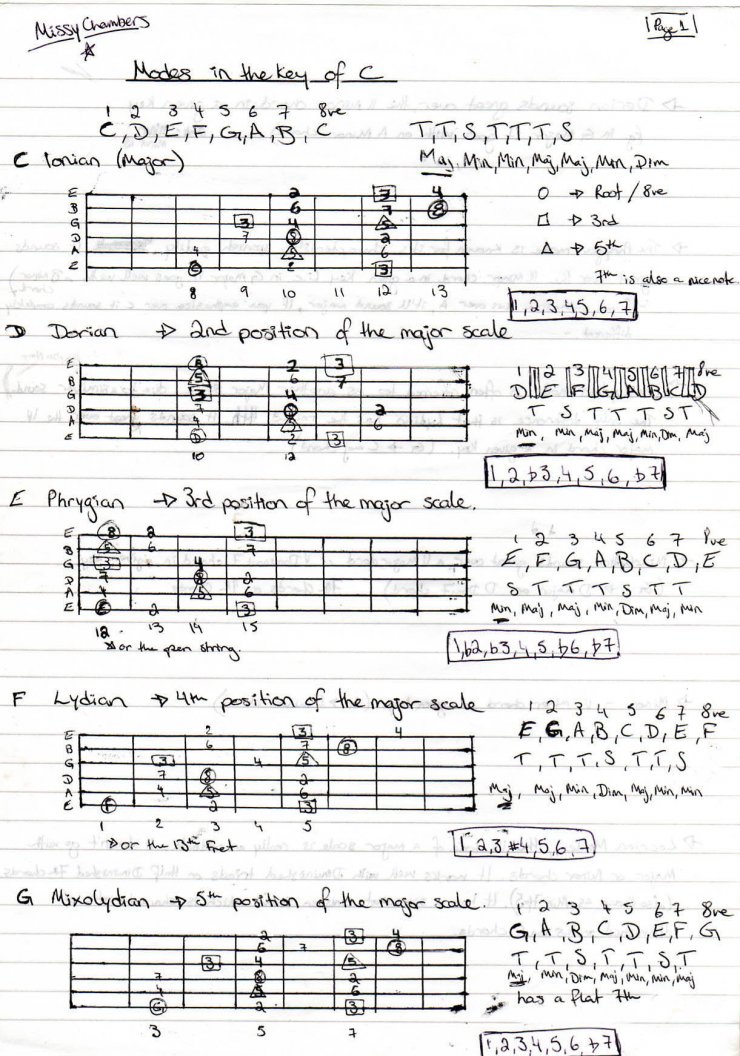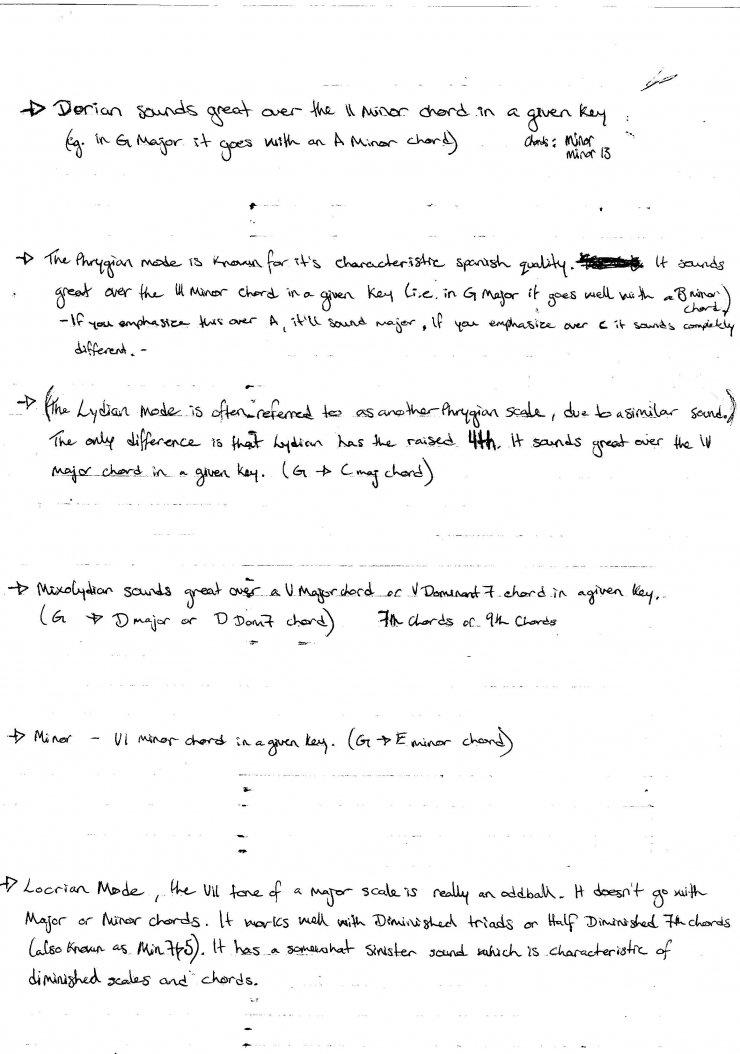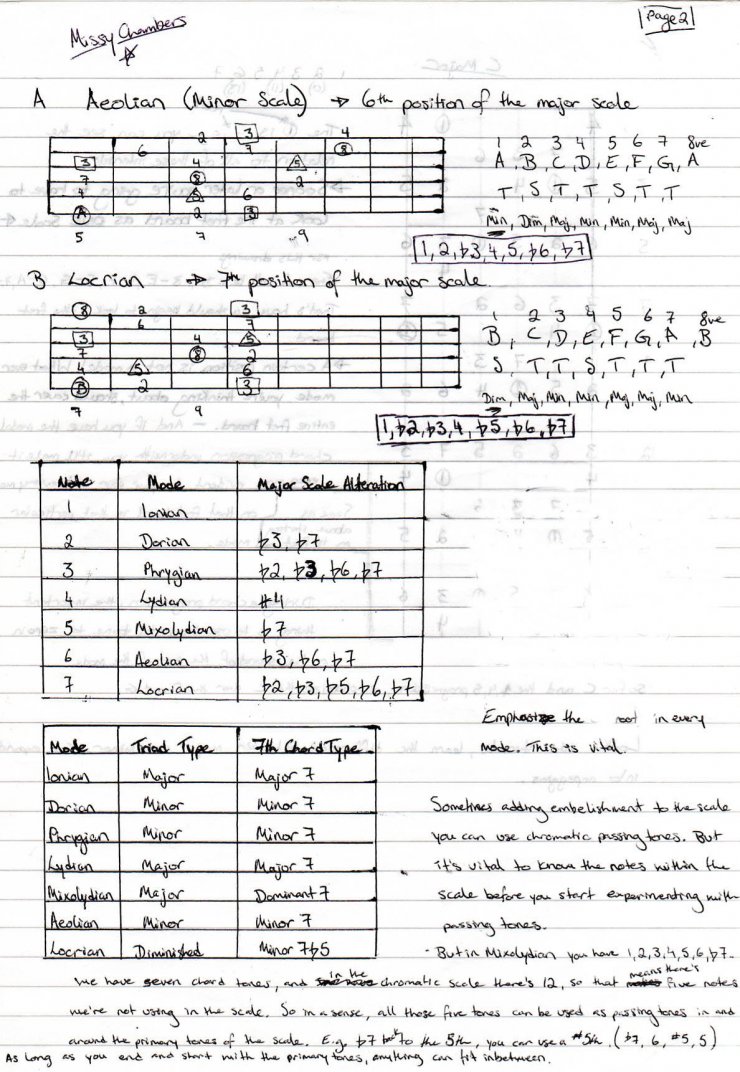If you play all of the major scale on the first string you'll see that each note you play is the start of another mode, until you come back to the first note. From this, you'll have Ionian (Major), Dorian, Phrygian, Lydian, Mixolydian, Aeolian (Minor), and Locrian. If you're not sure how to play it on the first string alone, it's G, A minor, B minor, C, D, E minor, F#diminished. Remember that every position of the major scale modes plays the exact note all the way through, but in a different position, meaning starting on a different note to make it look like a different scale/position.  For the actual table... I'm using the roman numbers on the top. The I is the first note in the key/scale, which I hope you all know. If not, learn now! :D This is really important to know, people. What you should understand with my little table here, is that underneith I've stated the Major scale and modes. I've also mentioned what style they're under. Just incase you can't see it...
The reason why there isn't an 8 (VIII) is because that is the octave. The first note but higher up.     Alright, when i say to look at the scale as one scale along the fret board, you DO NOT have to do that. I look at it a different way now. I see it with multiple values now. E.g. when you're improvising around the minor scale, it's also possible to play the melodic minor, the blues, minor pentatonic, harmonic minor, etc. This makes it more fun to improvise, also adds more possibilities while going outside of the original mode. If this is still too difficult, picture the major scale on top of these modes and compare. The modal positions are just an alteration of the major scale. But it's still using the exact same notes in any mode (of that particular key). Arpeggios are just chords. In time you'll be able to relate chords and arpeggios into the scale. They are bascally the sweet notes of the scale. Root, third, fifth and seventh are the most common arpeggios. Send me a comment if you're stuck with something, and I'll gladly help out. __________________________________________________________________________________________ Also, check out my music listed on Sound Cloud (link below) if you like it follow me on facebook! :) JazzMaverick on Sound Cloud JazzMaverick Music __________________________________________________________________________________________
Comments:
01
09.04.2008
02
09.05.2008  JazzMaverick JazzMaverick
Yeah, thought it'd be easier to put it on here, for everyone.
03
09.30.2008
04
09.30.2008
05
10.01.2008  JazzMaverick JazzMaverick
League; exactly. All of these "Modes" are just another starting point in the major scale.
06
10.02.2008  JazzMaverick JazzMaverick
Does this make sense to anyone who hasn't seen this? Please let me know if it doesn't, and I'll explain it in more detail.
07
12.05.2008  GRX40 GRX40
Sorry for bumping this old lesson, but this really helped. I was not really sure what to do with modes before this, since it just sounded like the major scale in a different place. But this, plus the 1,3,5,7 stuff, plus some old stuff I remembered from trumpet lessons, plus some fiddling around on the piano helped me realize that I could play these modes over the certain chords and it will sound good.
08
12.06.2008  JazzMaverick JazzMaverick
Awesome, great to hear that it's working for you. Glad both lessons are helping. Keep up the great practicing!
09
12.07.2008  guitarmastergod guitarmastergod
holy **!!! thank you!! ive been looking for something like this to help me understand the oder of modes, sorry for the swear
10
12.07.2008
11
12.30.2008  exp exp
** ** **! This is a good lesson, very clear.
12
12.30.2008  JazzMaverick JazzMaverick
It just sort of came to me after a while, I played everything so much that it became second memory and I can just see where it is without needed to think about it.
13
04.14.2009  duckaholic1187 duckaholic1187
ok. modes have been kickin my ass. i am a little confused. i understand your little lesson here totally without any questions, but there is one prob. that is really got me goin out of my mind. lets use Gmaj. as an ex. Im assuming that the Ionian=1,2,3,4,5,6,7 / Dorian= 1,2,b3,4,5,6,b7 / Phrygian=1,b2,b3,4,5,b6,b7 so on and so on..... are just the changes in the positions that the notes(G,A,B,C,D,E,F#) in any given mode are compared to the original position (Ionian). Correct? but the real kicker is, is that on the guitar scales tab (the one that has the fretboard that you can get any scale to show up on) they actually flat the notes not the positions. Ex. G ionian 1=G, 2=A, 3=B, 4=C, 5=D, 6=E, 7=F# / But in dorion mode, 1=G, 2=A, b3=Bb(A#), 4=C, 5=D, 6=E, b7=F. I hope you can understand what i said. if you can please explain because that thing goes against every thing your lesson is about and it is confusin' the ** out of me. And if it is wrong then they need to fix it because people like me are usin' it and learnin' the wrong stuff.
14
04.14.2009  JazzMaverick JazzMaverick
Yeah, I get what you mean. It's because you're starting on the same note, when it should be A Dorian, not G. Because you're in G Major.
15
04.14.2009  duckaholic1187 duckaholic1187
it just hit me like a ton of bricks. i feel like an idiot now. thank you for your time
16
04.15.2009  JazzMaverick JazzMaverick
Nah don't worry about it, it takes ages for everyone to figure that out. The good news is that you actually understood it :D So keep asking questions and you'll be catching up in no time.
17
05.08.2009  themntl1 themntl1
just found this ste and came across this post. all i got to say is thank you, from the novice "knows nothing" to the Vet who "knows a lot but not all". this post was very well done and the epiphany i has by looking "not reading it" was amazing, I look forward to more posts from you THANKX!
18
05.10.2009  Admiral Admiral
Thanks man, it's a good lesson. Love the pictures )
19
05.13.2009  CacophonyJackson CacophonyJackson
Great lesson. It has totally helped me understand modes and it will definitely help me in creating my own music. I was wondering, since I have learned the major scales modes, are there other scales that can be used and applied to this, or because the major scale is the center of it all that's the only one. I know quite a few scales but it seems like they are just modes of the major scale. Oh, I just had the though of the harmonic minor. If so, how many scales can use this technique? I would like to learn them all. Thanks
20
05.15.2009  JazzMaverick JazzMaverick
Admiral,
21
05.16.2009
22
05.16.2009  CacophonyJackson CacophonyJackson
Ah okay, thanks. I will work on getting the major scale down completely, and then I'll work on the harmonic minor, since I use that one quite a bit. Appreciate it.
23
06.05.2009  EncaLapenca EncaLapenca
It is confusing. Do You meen that if I play a solo over chords G, Am, Bm, C, D, Em, I am in tune if I play G major scale over whole nack?
24
06.05.2009
25
06.05.2009  soy.el.che soy.el.che
so thats what modes truly are....... im disappointed. I had hear that before, that modes were only playing a scale strarting not on the root note. i thought it would actually be a lil deeper. lol. now i know what modes are.
26
06.06.2009  JazzMaverick JazzMaverick
Oh no no no! Modes can become your best friend! There's a lot more to learn about modes Soy! I mean, the greats know crap loads more than just the modal positions, if you dive in and take a small gulp, you'll definitely come back for more.
27
06.07.2009  EncaLapenca EncaLapenca
Thanks. I understand that. I have never learned theory, can’t read notes or tabs (playing by ear, harder way). So I took “Reverse scales” tool on this site for testing Hendrix “Hey Joe” so as I am playing that.
28
06.12.2009  EncaLapenca EncaLapenca
Don’t answer my question. My stupidity is really huge. Your lessons explain all things I was wondering about, but my loss of knowledge made that I didn’t understood that.
29
06.12.2009
30
06.25.2009  EncaLapenca EncaLapenca
Thanks to lessons on this site I understand modes now.
31
06.25.2009  carlsnow carlsnow
[b]@ EncaLapenca[/b]
32
06.25.2009  carlsnow carlsnow
sorry y'all (dunno where the edit button is)
33
06.25.2009  carlsnow carlsnow
sorry again *grumps the grumpy geezer* BUT i should have made note
34
06.26.2009  EncaLapenca EncaLapenca
Tanks for your answer "carlsnow".
35
06.26.2009  carlsnow carlsnow
Erica,
36
06.26.2009
37
07.02.2009  bull_dog998 bull_dog998
my ? is on soloing with the modes; so if i was soloing GM, Cm ,DM. I would use G-ionian ; C-lydian ; D-mixolydian; and i could use the relective E minor ; TO SOLO OVER THOSE CHORDES RIGHT? thanks haveing troulble here ;
38
07.02.2009  Guitarslinger124 Guitarslinger124
Do you mean G major or G minor. I'm assuming you mean G minor (because G major is written as only "G"). You could play A# Ionian, C Dorian, D Phrygian, D# Lydian, F Mixolydian, G Aeolian and A Locrian. You could also play D Aeolian, that would sound neat.
39
07.02.2009
40
07.02.2009  JazzMaverick JazzMaverick
Well, when you solo over these chords it's best that you compliment these chords, that way your solo would sound melodically correct and just plain cool.
41
07.02.2009
42
07.03.2009  EncaLapenca EncaLapenca
I am a novice when it comes to modes but I am fighting :-)
43
07.03.2009  JazzMaverick JazzMaverick
That's right :) Keep practicing and you'll start discovering things on your own. Also, constantly learn other songs so you can improve every day. Learn a new chord every day and study it, find out what scale it belonds to and why. For now, just study the basic chords until you're ready to look at other scales.
44
07.03.2009  EncaLapenca EncaLapenca
Thanks!
45
08.29.2009
46
09.01.2009  ckimball03 ckimball03
jazz in the major scale box you write out c# major with only 5 #
47
09.01.2009  ckimball03 ckimball03
jazz on the other hand i have read all of your lessons on this site and you are the easyest to learn from you know your music very well rock on.Keep the good lessons coming to.
48
09.01.2009  JazzMaverick JazzMaverick
Hey Craig, Thanks for the compliments, I'm glad I was able to help you out. About the sharps in C#... I know everything is a sharp in C#Major, BUT B# is C and E# is F I just thought I'd write it like that for the beginners because they have a difficult time understanding it any other way.
49
09.01.2009  ckimball03 ckimball03
Hey jazz i have a ? not sure how to ask but here goes.
50
09.01.2009  JazzMaverick JazzMaverick
Well, I'll say right away; pick up your guitar and apply what you're learning now otherwise you'll struggle. I got so carried away with studying that when it actually came to playing, I played like a noob.
51
09.02.2009  ckimball03 ckimball03
back to my question still not sure how to ask it lol.
52
09.14.2009  mrpothead mrpothead
Hey thnx for the lesson it was really helpful [as anyone says]
53
10.16.2009  apollos apollos
ugh im confused i cant even get passed the firsti ntro sentences on ur lesson...can u just post tabs of the diff modes so i can compare them and find out like that?
54
10.16.2009  JazzMaverick JazzMaverick
Tabs are a very poor way of learning music, as simple as it is for others, I recommend you learn how to read notation rather than TABs. Ontop of that, if you are finding this lesson THAT difficult, I recommend that you check out simpler lessons first - this is too advanced for you right now. (For your own sake just check out the major scale right now)
55
10.17.2009
56
10.18.2009  Empirism Empirism
I try to answer this Josh, if Jazz is busy. It means Tone and semitone. Im not sure if it reffers to Whole step, half step stuff.
57
10.20.2009  JazzMaverick JazzMaverick
Yeah, Empirism is right; it means tone and semitone and in America Tone and Semitone are known as Whole step and Half Step.
58
01.10.2010  sslug sslug
Dude reading your posts are cool, you have a very good way of explaining things.... wish the girlfriend had that quality....
59
01.10.2010
60
03.19.2010  thomasj thomasj
amazing lesson man! just gotta work on getting all this in my head... it could take a while.
61
03.19.2010  JazzMaverick JazzMaverick
Patience Tom =) it'll pay off in the end if you take your time with this - don't rush through it even if it may seem boring at times.
62
03.19.2010
63
04.01.2010  gmack gmack
I remember it with a catchy phrase:
64
04.08.2010  Deathlegend Deathlegend
I don't understand much of this, sorry -_- hopefully you can help. The only bit i THINK i understand is modes in the key of C. (Now I'll probably sound like a noob in all of this) i play exactly what you've written there but i don't think i''m meant to play every note in the scale's? I'm self taught so I'm trying to learn theory and this site has helped me a lot so far and I'm trying to get my head around this. I don't know if I'm suppose to start and end on certain notes, or just play the whole scale. If you could help I'd greatly appreciate it.
65
04.09.2010  Guitarslinger124 Guitarslinger124
You can play whatever you want man. The scales and modes are just guidlines. You don't have to play every note in the scale, or play them in order.
66
04.09.2010  JazzMaverick JazzMaverick
Please look at post number 14. I wrote a little example explaining the positions of the scale and the modes inside it.
67
04.10.2010  Guitarslinger124 Guitarslinger124
I must have misunderstood the context of that question, apologies if I caused any confusion.
68
04.14.2010  KicknGuitar KicknGuitar
gmack, my favorite is, |


